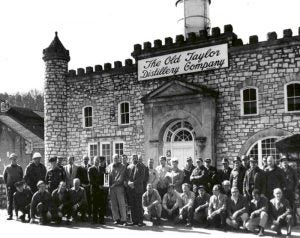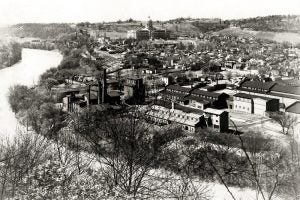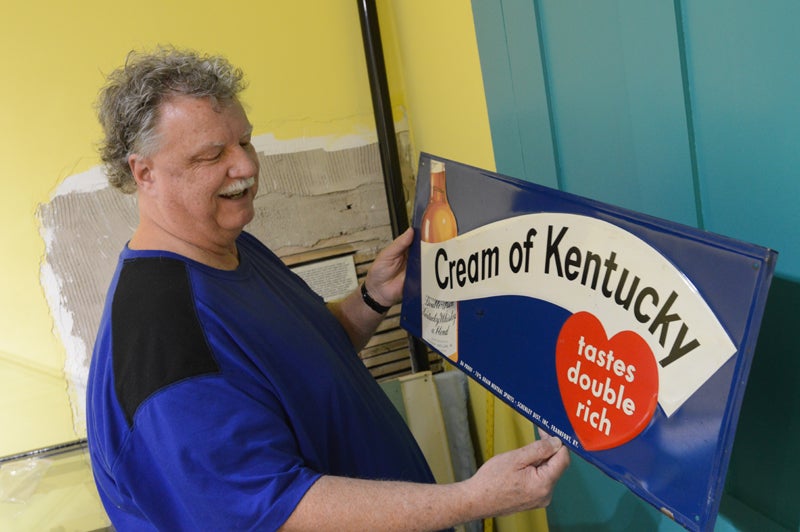Ross Onan Jr.’s collection of bourbon memorabilia is more impressive than many. Mostly from the early 1900s, Onan estimates he owns 10 signs, 20 bourbon bottles with labels that have Frankfort ties and a bevy of miscellaneous items.
The method to his bourbon collecting is simple — grab anything with Frankfort on it.
“You know, there was so much turnover in the distillery owners that I’ve got a bunch of old labels with some ungodly names you’ve never heard of,” Onan said. “Now, they will all have Frankfort on them. I don’t buy one unless I absolutely know that it was a Frankfort brand like Old Oscar Pepper or Old Taylor, but if they’ve got Frankfort on them I’ll buy them.”
His collection includes an old mallet that looks well-worn. He also owns a “whiskey thief,” but not the same one master distillers used for quality control. His “whiskey thief” was used by distillery workers to snag a shot or two of liquor.
His collection also includes old signs and advertisements. As he talked about his collection, Onan paused to talk about one in particular.
“Oh yeah,” Onan exclaimed. “This one right here is ungodly old. It’s like 1904, I think. It’s for Old Fire Copper Whiskey, the George Stagg Company in Frankfort. That one there is probably the oldest advertisement I’ve got that’s survived.”
There’s no particular reason for Onan’s collecting habit, which extends beyond bourbon. He joined the e-commerce website eBay in 2001 and joked that he had “disposable income” during his time working at Toyota in Georgetown for 17 years. He also worked at the University of Kentucky for a number of years, and has a sizable collection of UK memorabilia that he’s in the process of transferring to his son.
Where does he keep everything? Onan converted his garage into what he calls “The Frankfort Mini Museum” to house many of his collectables, but now he’s loaning an array of his bourbon exhibit to Capital City Museum for an exhibit later this month that organizers hope will draw crowds of people from across the U.S.

Photo submitted – Employees of Old Taylor Distillery pose outside with a safety award in March 1973.
“The biggest we’ve ever done”
The bourbon exhibit is set open April 20 as part of a renewed, local effort to better market Frankfort’s bourbon history. The bourbon exhibit’s grand opening and ribbon is scheduled for 5:30 p.m. on April 20. At 10 a.m. on April 21, the exhibit will be open to the general public. A bourbon-related walking tour, led by Don Stosberg, and trolley tour, led by Russ Kennedy, will also launch around the same time. Bourbon and Browns — the major fundraiser for Liberty Hall Historic Site — is scheduled for April 21. If the exhibit and other bourbon-related events are successful, local officials would lure a portion of the more than 200,000 people that annually visit Buffalo Trace into downtown.
Historian Russ Hatter said the walking tour will be “the biggest we’ve ever done.”
John Downs, museum curator, said he was initially hesitant when asked if he could pull off the an exhibit because of the success of past displays and the rich history of Kentucky’s native spirit in Frankfort, but the idea became more attractive the longer it distilled in his mind.
“We only get 15,000 people a year here,” Downs said. “If I can get a handful of the 200,000 people who only come to town to go to Buffalo Trace and leave, then yes I want to do it. The community came to me and asked if I want to do it, and I said yes.”
Capital City Museum recently wrapped up a fishing reel exhibit that was one of the facility’s first to last for more than a year, and Downs projects the bourbon display will be even more popular than that.
“When we opened the fishing reel exhibit, there were people who couldn’t get in because it was wall-to-wall people,” Downs said.
He’s hoping the same is true for the bourbon exhibit, which is scheduled to be on display until at least October 2019. The exhibit will take up one room and part of the museum’s downstairs hallway.
Downs said he’s particularly excited to display an apparatus whose creator claimed it would automatically age whiskey by two years.The apparatus contains wooden framing and barrels connected by brass piping. A model of the apparatus was on display at the 1882 Southern Exposition in Louisville, Downs said. According to the family, who did not want to be identified, bourbon icon E.H. Taylor owned a version of the apparatus and used it in his distillery to get a purer product before the Bottled in Bond Act, which required spirits to be aged and bottled according to a specific set of regulations.
Two other items in the bourbon exhibit are owned by Kenneth Chism, whose father worked for Buffalo Trace Distillery when it was known as George T. Stagg Distillery. One is a commemorative ashtray. The other is a bottle of Old Crow bourbon created for the 200th anniversary of Frankfort. There were only 200 bottles made.
“Daddy went and got it the very day they put it in the liquor stores because he knew the liquor store owner,” Chism said. “He brought it up to me that very day. I set it on a shelf, and it’s been sitting there ever since.”

Photo submitted – This image shows a view of Hermitage Distillery in the foreground and South Frankfort and the State Capitol in the background.
A wider effort
Capital City Museum’s bourbon exhibit and other bourbon-related activities in Frankfort in April are the brainchild of Downtown Frankfort Inc’s Bourbon Strategies Committee. The committee is led by René True, who said it’s critical for Frankfort to take advantage of its existing bourbon assets and history related to Kentucky’s native spirit when announcing the slate of bourbon-related activities in December.
Kellly Everman, Downtown Frankfort Inc. director, reflected on the upcoming exhibit by saying the city hasn’t done the best job of using its bourbon assets to its advantage. The events in April aim to do just that.
“Here we are, sitting on a wealth of bourbon, and nobody has really tied it all together so that it becomes cohesive,” said Everman. “Maybe we didn’t see the forest for the trees or we took it for granted until the last year or so because it’s so much a part of the culture … I really feel like Frankfort is beginning to come into our own and that we are beginning to value ourselves even more.”
Claim to fame
Downs and Hatter said that each distillery and family has its own claim to fame related to bourbon. Bardstown calls itself the “Bourbon Capital of the World.” Each distillery brags about some “first,” Downs says. As it begins to market and capitalize on its history, perhaps the niche for Frankfort to claims is the “cradle of bourbon.” Downs tells the story that may make the claim possible.
James Wilkinson, who owned the land on which Frankfort was founded, wanted Frankfort to be a shipping port, but it was illegal to trade with the Spanish, Downs said. At the time, the Spanish owned the Mississippi River at New Orleans, but Wilkinson was determined to be rich and famous, Downs said.
“So, he gathered a bunch of product together, put them in flatboats, and when the Kentucky River at Frankfort flooded in 1787, on his flatboats were American-style corn whiskey that was distilled in what would later become Kentucky,” Downs said. “That product would later be known as bourbon. In 1787 it was just whiskey, but what became known as Kentucky bourbon first went out into the world in 1787 on the banks of the Kentucky River here in Frankfort.”
Asked about the claim of being the “cradle of bourbon,” Hatter said, “I think we’ve got a shot.”
“Franklin County is just loaded with the history of the bourbon industry,” he said. “There was just so much here and so many families that were important.”










